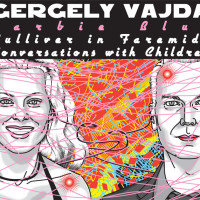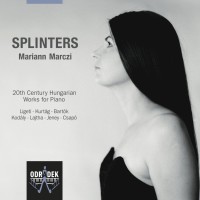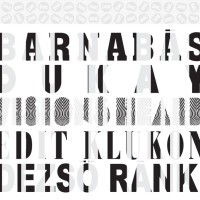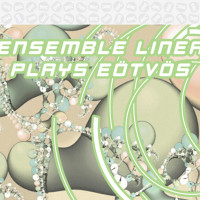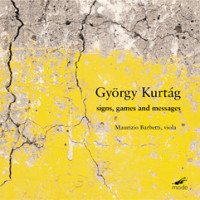Hungarian Holiday 3.
|
Grant Chu Covell [July 2014.]
Gergely VAJDA: Barbie Blue (2006)1; Gulliver in Faremido (2010)2; Conversations with Children (2008)3. Dóra Érsek1 (sop), Róbert Rezsnyák1 (bar), Tibor Szervét2 (narrator), MR Symphony (Hungarian Radio Symphony Orchestra)1, UMZE Ensemble2, Dèdalo Ensemble3, Gergely Vajda1,2, Vittorio Parisi3 (conds.). BMC Records BMC CD 202 (1 CD) (http://www.bmcrecords.hu/). Intended as comic contrast to Bartók’s Bluebeard’s Castle, Vajda’s 30-minute Barbie Blue gives the woman the upper hand. Seven scenes echo Bartók’s seven doors as Mrs. Blue lurches through different emotional states after her husband returns home inopportunely. The style is contemporary and fluid, sung in Hungarian (English texts appear in the booklet). Also a half-hour, Gulliver in Faremido is more comprehensible thanks to the English-language text. In this continuation of the familiar satire, Gulliver arrives at a land populated with machines that communicate through music. These machines believe they are superior to all organic creations and Gulliver eventually agrees with them. Vajda’s website implies that the narrator and five players (alto flute, clarinet, violin, cello and piano) also play percussion (vibraphone and bells). The same lineup also provides the scant nine-minute Conversations with Children, a purely instrumental work mimicking “the playfulness of kids’ talk” through frisky gestures, naïve motifs and abrupt but decisive changes.
“Splinters.” György KURTÁG: Splinters, Op. 6d (1978). György LIGETI: Fém (1989). Zoltán KODÁLY: Méditation sur un motif de Claude Debussy (1907); Seven Pieces, Op. 11 (1910-18). László LAJTHA: (…de l’automne et du champ…), Op. 2, No. 10 (1914). Béla BARTÓK: Trios Burlesques, Op. 8c (1908-11, rev. 1912). Zoltán JENEY: Ricercare (1992); Arthur Rimbaud in the Desert (1976). Gyula CSAPÓ: The Ultimate Goal (1986). Mariann Marczi (pno). Odradek ODRCD307 (1 CD) (http://www.odradek-records.com/). Kodály is the anchor for this Hungarian program. The Méditation and seven Op. 11 pieces join Debussy’s impressionism and keyboard technique (e.g., Nos. 1 and 5) with Magyar tunes (e.g., Nos. 2, 6 and 7) suggesting that modern Hungarian music has French ancestry. Kurtág’s Splinters comprise four modest pieces (I looked at the cimbalom version here) indebted to Webern and decidedly contemporary. All of Ligeti’s Études are in Marczi’s repertoire. She has written extensively on them and has selected her favorite, Fém from Book II. It’s not my top pick, nor do I think it representative, but then, I can’t play any of them. Largely overlooked today, Lajtha worked with Bartók and Kodály on their folk tune-collecting expeditions. He is represented here by terse Viennese expressionism. In contrast, Bartók’s jagged Burlesques are immediately identifiable. Marczi’s animated Ligeti and Lajtha contrast with the familiar but cool Bartók. If Kodály had meant to draw a line from Debussy, it’s evident that Bartók severed it. Are contemporary Hungarian composers still reacting to Bartók? Jeney and Csapó contrive to make the opening Kurtág and Ligeti appear traditional. Jeney’s two calm pieces contradict Kurtág’s intensity. Ricercare’s understated motion hides canonic activity whereas Rimbaud gradually replaces pitches with silence. Like Jeney, Csapó similarly sidesteps Kurtág and Ligeti’s organizational intents with a chain of gestures, some echoing other styles, completely disregarding form and structure. Are there hints of the extinct tunes which Kodály, Bartók and Lajtha collected or does it not matter?
“Visions Heard.” Barnabás DUKAY: Invisible fire in the winter night; Visions heard of light and love; …, who rests in their own silence; Burning longing – voluntary surrender; At the well. Edit Klukon, Dezső Ránki (pnos). BMC Records BMC CD 147 (1 CD) (http://www.bmcrecords.hu/). BMC’s intricate presentation and packaging invites investigating all the panels and surfaces, yet there are no notes for these two-piano pieces. The analytic listener has nothing but the airy titles. I couldn’t find composition dates on the Internet. Dukay’s two-piano works are for the most part gentle and relaxed. Imagine the genial aimlessness of early Cage or Pärt without the tunes. The release administers a specified program as silent tracks separate the pieces. You’re to put this on the platter and enjoy. Invisible fire in the winter night moves quietly. Visions heard of light and love asks for more activity until a slow chorale progression. …, who rests in their own silence returns to slowness. Burning longing is the exception with mild dissonance and Webern-like shapes, after which At the well returns to the less dissonant white-note style. At the well has three parts. The middle movement of this contemplative set elaborates slow motion with trills. As relaxed as the music sounds, it’s hard work and Klukon and Ránki have the knack.
Peter EÖTVÖS: Sonata per sei (2006); Octet Plus (2008); Natasha (2006); Un taxi l’attend, mais Tchékov préfére aller a pied (2004); Erdenkalavier – Himmelklavier Nr. 2 (2003-06); Psy (1996); Cadenza (2008). Ensemble Linea, Jean-Philippe Wurtz (cond.). BMC Records BMC CD 175 (1 CD) (http://www.bmcrecords.hu/). Eötvös prefers to tell stories like Beckett and Chekov. Sometimes he uses grand opera; this release offers miniature theatrical works. Octet Plus adds a soprano to eight winds (flute, clarinet, two each of trumpet, trombone and bassoon) with bits of Beckett’s radio play Embers. There’s a taxi waiting for Chekov, but he’d rather go on foot makes clear its subject, but it’s a piece for solo piano. Natasha would appear to be a shard from Chekov’s Three Sisters scored for soprano, violin, clarinet and piano. The disc opens with the six-player sonata, reminiscent of Bartók’s sonata for pianos and percussion: two pianos, sampler and three percussionists. The fourth of five movements is explicitly titled “Bartók crosses the ocean.” It’s perky and bright, antiphonal pianos among distributed percussion, the synthesizer contributing decidedly non-Bartók timbres. The two short solo piano items run in sequence and may inadvertently blur. Erdenkalavier – Himmelklavier Nr. 2 starts from a similarly named piece by Berio. Psy distills a concertante work into a trio for cimbalom, flute and cello. Cadenza is for solo flute.
“signs, games + messages.” Leoš JANÁČEK: Sonata for Violin and Piano (1914-21). György KURTÁG: Var. pieces from Játékok (1973-) and Signs, Games and Messages (1961-); Tre Pezzi, Op. 14e (1979). Béla BARTÓK: First Sonata for Violin and Piano (1921). Jennifer Koh (vln, voice), Shai Wosner (pno, voice). Cedille Records CDR 90000 143 (1 CD) (http://www.cedillerecords.org/). We’ll admit the 17:35 Janáček Sonata into this roundup as one of Kurtág’s pieces references the Czech composer. Janáček’s four movements fall just outside the traditional Sonata form, with gruff violin figurations against smooth piano cascades. Koh is coarse, then tender, against Wosner’s Romantic arabesques. Kurtág’s miniature novels call for emotions. Their menu requires violin and piano, some solo violin, some solo piano. Two pieces ask for speaking. After sensual Janáček and Kurtág, both players abandon niceties for Bartók’s severity.
György KURTÁG: Signs, Games and Messages (1961-2005); Szorongòs es vigasztalòs H. J.-nek (1994); Illés Arpadné emlékére (1996); Mesto, lacrimoso (1992); Misterioso – altero (1993, rev. 1998). Maurizio Barbetti (vla), Gianpiero Ruggeri (bar). mode 230 (1 CD) (http://www.moderecords.com/) . Akin to Beethoven’s Bagatelles which examine small ideas, Kurtág’s miniatures add an additional dimension. We know Beethoven’s pieces by their movement title and opus number (e.g., Op. 126, No. 3, Presto) whereas Kurtág’s titles may specify an association through a dedication to a specific person or an event (e.g.: “For Imre Földes at 60,” “…To the exhibition of Sári Gerlóczy,” “…eine Blume für Tabea…,” etc.). Some of the pieces are in memoriam (Aczél György, Thomas Blum, György Kroó, et al.), as farewell gestures or elegant summaries. The specific designations add to the intensity and mystery. The 24 viola pieces of Signs, Games and Messages are offered in their entirety for what appears to be the first time. Kurtág is a continual reviser; some of the short pieces necessitated long gestations and updates. Four additional solo viola pieces complete this modest program (just under 50 minutes). Most all are first recordings. Baritone Ruggeri joins for Samuel Beckett: le nain – Hommage à Roland Moser. The low male voice startles. Barbetti has a rustic, penetrating quality. Not steely smooth or aloof, but sensual and personable. His reading is that of a man possessed. Notes are by Nicola Sani whose Elements were covered here. On a personal note, Sani was a generous host during my visit to the Scelsi house. Kurtág followers know that Kim Kashkashian provided 19 of these pieces on ECM 2240 (with the Ligeti Solo Viola Sonata). The Orlando Trio (Hirom Kikuchi, violin; Ken Hakii, viola; Stefan Metz, violoncello) presented a 19-piece collection alternating solo and trio versions on ECM 1730 (with Kurtág’s Hölderlin-Gesänge and …pas à pas – nulle part…). ECM’s acoustic is boomier. Barbetti, recorded closer, avoids being smeared by excessive reverb.
[More Grant Chu Covell, Hungarian Holiday]
[Previous Article:
Charlie Haden]
[Next Article:
(Dis)Arrangements 4: Mozart and Tchaikovsky]
|
